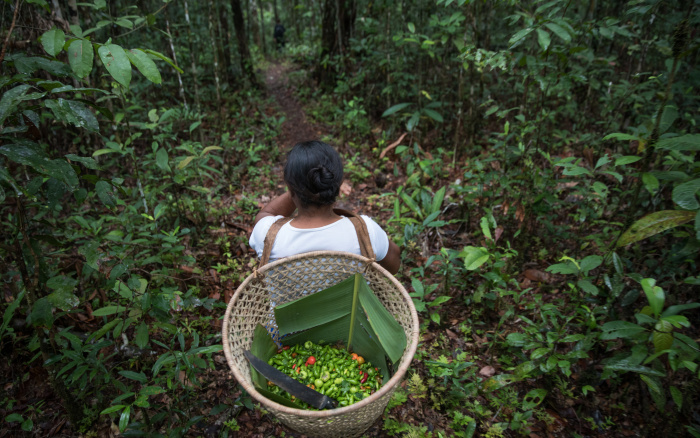Você está na versão anterior do website do ISA
Atenção
Essa é a versão antiga do site do ISA que ficou no ar até março de 2022. As informações institucionais aqui contidas podem estar desatualizadas. Acesse https://www.socioambiental.org para a versão atual.
Biodiversity: the countdown
Thursday, 27 de February de 2020 
Nurit Bensusan, ISA advisor and biodiversity expert
Do you think you can count down from 533 to 0 in one minute? If the answer is “no”, it means that you cannot count the loss of trees in the entire Xingu River basin, for this is the average number of trees that were felled there, 533 a minute, in 2019.
Another difficult countdown is the number of species on the planet. It is estimated that from two hundred to two thousand species disappear from the globe yearly. Furthermore, we don't even know if we should start counting at 2 million or 10 million. Although science has already described about 2 million species, there are many others still unidentified that can add up to many millions. In other words, we are losing species that we haven't even gotten to know.
We can also try counting down ecosystems. Each year, several of them are drastically reduced. In the Amazon alone, almost 10,000 km2 of forest disappeared last year. The Cerrado ceases to exist before our eyes, like many other ecosystems in the world, such as the underwater seaweed forests of Alaska, the Aral Sea in Uzbekistan, the acacia forests of the Senegal River basin, the Cape Fynbos in South Africa, the Rhine peat bogs in Germany and the swamps of the Murray-Darling estuary in Australia. The number of existing ecosystems on the planet decreases rapidly…
Another accelerated countdown is that of environmental services. These are services that nature offers us free of charge, such as water quality and availability, soil fertility, pollination and pest and disease control. They are rapidly degrading. In some places, which we can count on progressively, these services have deteriorated so much that they had to be replaced by expensive technological alternatives, thus restricting their access to those who can afford them, therefore causing enormous suffering for most human populations who cannot do so.
The Conference in October in China
At this moment, an important count for biodiversity is the countdown to the 15th Conference of the Parties to the Convention on Biodiversity (COP15), which is approaching and is scheduled for October, in China. COP 15 will discuss the convention targets for the next 10 years, in a scenario of crisis in multilateralism and its instruments, accelerated biodiversity loss and worsening of the climate crisis.
In other words, we are immersed in countdowns. On the one hand, there is COP 15 and the hope that more effective measures will be taken to stop the destruction of biodiversity. On the other hand, we account daily losses: fewer species, fewer animal populations, fewer plant communities, fewer ecosystems and, more than anything, fewer and fewer possibilities for the future.
The first draft of what may be the set of goals for the so-called post-2020 agenda is now available (CBD/WG2020/2/3). The framework designed to promote the necessary transformations fails to bring anything effectively new and, when it points to a more ambitious direction, such as eliminate subsidies and reform economic sectors to adapt to sustainability while reducing the impact on biodiversity, it does not offer innovative instruments to do so. This first draft also bets on the engagement of all players, that is, governments and societies in the convention member countries.
The Aichi Biodiversity Targets, as the convention goals for the last 10 years (2011-2020) are known, did not prevent the accelerated destruction of nature. There was no significant engagement on the part of the countries to reverse the countdowns and there is absolutely nothing, at this point, that would suggest that the scenario for the next decade will be better. So, it is difficult to believe that the convention will be able to adopt measures that reduce biodiversity loss.
And what does the Bolsonaro government have to do with that?
Brazil's power and influence in the convention is also regressing. In fact, they are in free fall. Until recently, the country was an important player in the game, not only for having the greatest biodiversity on the planet, but also for proposing instruments and alternatives, as well as negotiating skillfully, with its famous soft power, and promoting consensus. With the end of this attitude in multilateral treaties and with an anti-environmental discourse, increasingly translated into practices harmful to biodiversity, the Brazilian government is not likely to help build the post-2020 agenda. On the contrary, as the decisions of the convention require consensus, it is expected that Brazil will become an obstacle to the adoption of an agenda with more effective commitments. The Bolsonaro government already has a negative precedent: it played the role of one of the main villains, hampering negotiations at the 25th Conference of the Parties (COP 25) on Climate Change, in Spain, last year.
The cruellest countdown, however, is that of hope. This one is approaching zero quickly. Without more effective commitments, without the political will to build a sustainable and fair future for humanity and without understanding the extensive role that biodiversity plays in the maintenance of human life, there will be no world to come...
Stay up-to-date
What is biodiversity?
Biological diversity, or biodiversity, is the variability among living organisms from all sources, including, inter alia, terrestrial, marine, other aquatic ecosystems and the ecological complexes of which they are part. It also includes the diversity within species, between species and that of ecosystems. Brazil is the nation with the greatest biodiversity in the world.
What is the Biodiversity Convention (CBD)?
Signed at Eco-92, the Biodiversity Convention (CBD) is an international multilateral treaty ratified by more than 180 countries. Brazil ratified the CDB in 1994 and, from then on, the convention became part of its legislation. It has a set of articles that provide guidelines for national public policies, for instruments for the conservation and sustainable use of biodiversity and for the implementation of mechanisms, for all sectors of society, to protect biodiversity and ecosystem services. One of the documents signed by Brazil under the convention (the Cartagena Protocol on Biosafety) has the force of law. The convention has three main objectives: to conserve biodiversity, to promote its sustainable use and to share the benefits derived from that use. The CBD created a set of targets to be achieved by the participating countries for the past decade and for this one on different topics. Although the CDB is 28 years old, its results are limited and it has not been able to stop the loss of biodiversity that is already reaching worrying levels, a situation aggravated by the climate crisis. At this conference in 2020, new goals for the next decade will be established.
What are ecosystem services?
They are the contributions of nature to the maintenance of human life, providing the basis for its physical, economic and cultural reproduction. These services are provided by healthy ecosystems: water quality and availability; air purification; climate regulation and prevention of severe weather phenomena and natural disasters, such as cyclones, tornadoes, droughts, floods, landslides, heat or cold waves; biological and genetic diversity; decomposition of wastes; soil fertility and erosion control; pollination and seed dispersal for agriculture and natural environments; pest and disease control; supply of wood, food, fibers, medicinal and cosmetic substances and other genetic resources, etc.
Imagens:



